#pokemon science
Text
youtube
I really need to share this with everyone
#clodsire#pokemon#scientificpokedex#pokemon science#pokeearth#planet earth#david attenborough#Youtube
304 notes
·
View notes
Text
Nidoran Male and Nidoran Female are not separate species, they're just different forms of the same Pokemon.
The reason they have separate Pokedex entries is due to an old error that still hasn't been fixed, because it would cause too much hassle renumbering everything.
106 notes
·
View notes
Text
I managed to turn a university project into me essentially ranting about "but what if this Pokémon was REAL???" for 1500 words. I'm a zoology student and last year at uni we had an assignment where we had to create our own fictional reptile and write up a report on it as if it was a real species. The main thing we were asked to do was to give it a novel trait that hadn't been seen in this type of reptile before, but to keep it grounded in something that could feasibly exist (i.e. no dragons that can breathe fire or have a six limb body plan). Ok, so no fire production... but electricity is a different question (more on that coming up). I present to you, my submission for the assignment, the Black-frilled Agama (Chlamydosaurus ulurus), based on one of my favourite Pokémon, Heliolisk.

In real life, there is only one living species of the Chlamydosaurus genus: the frilled lizard (C. kingii), which is native to the northern areas of Australia and have an arboreal lifestyle. C. ulurus, however, is found a bit further southward in the rocky area of the Uluṟu-Kata Tjuṯa National Park, which is where the second half of its binomial name comes from. Sadly, I couldn't just have this lil guy shooting off thunderbolts left right and centre to keep it realistic, but I was still able to encorporate its shocking abilities in my report thanks to some other living non-reptilian animals: electric fish. These fish possess an organ that allows them to generate an electric field. "But those are all fish, how would the same organ just evolve in a reptile species as well? Seems pretty unlikely" I hear you scream at me through your screen, foaming at the mouth. Here's the cool thing: this organ has evolved separately several different times in fish in a process called convergent evolution. Not all electric fish share a single ancestor that was the originator of this organ, meaning I could argue that because it has evolved independently in separate lineages before, that it was also at least possible if not probable for it to evolve in a reptile species.
But why??? What possible benefit would this lizard gain from evolving such a niche trait? The argument I made was that as C. ulurus is bigger and slower than C. kingii, yet still employs the ambush hunting technique that C. kingii uses to find food. Its electric organs are found in the tail, and while the electric field generated isn't strong enough to kill the prey it hunts, it's enough to stun the prey for enough time to stop them from escaping.
This has been my absolute favourite project I've done during my time at university and I wanted to share it with the fellow Pokémon nerd zoologists of the internet, for once I wasn't up all night stress finishing a project because I'd left it until the last minute. Instead, I was up all night for several nights researching because of how much I genuinely loved working on this assignment. So much better than the many nightmare group projects of "get four people who have never spoken before to make a poster/short video on the driest topic ever".
#pokemon#zoology#science#biology#taxonomy#heliolisk#pokemon science#evolution#convergent evolution#uni#uni assignment#jim i'm a scientist not an artist i don't know how the pixel quality of the picture got so fucked
138 notes
·
View notes
Text
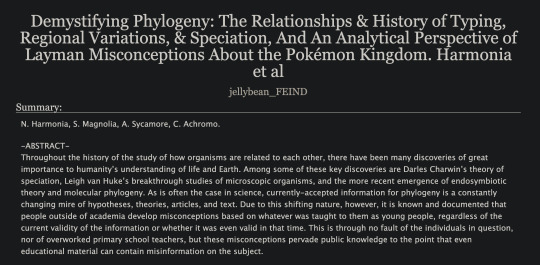
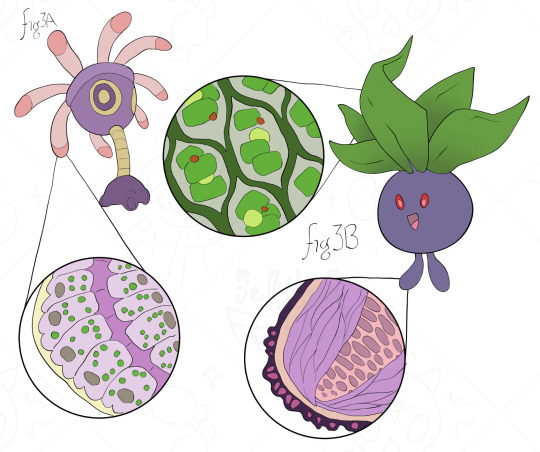
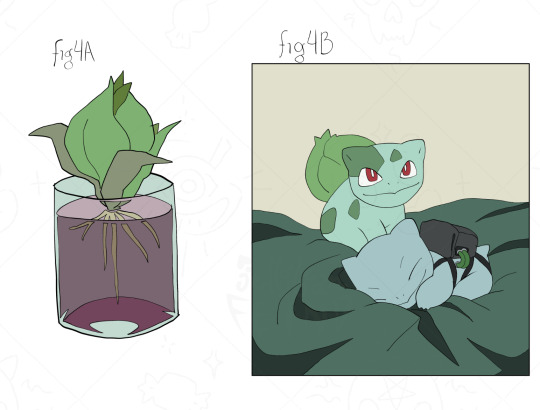

Demystifying Phylogeny: The Relationships & History of Typing, Regional Variations, & Speciation, And An Analytical Perspective of Layman Misconceptions About the Pokémon Kingdom. Harmonia et al
5.5k words. I finished this like two days ago but I needed to draw diagrams because that's just the kind of person I am. Anyways if you're someone who likes paleobiology and phylogeny and pokemon and wants to read 5.5k words of those topics smooshed into one sizeable infodump in the format of a scientific article... I've got you covered like nobody else does lol.
360 notes
·
View notes
Text

Something I doodled a few years ago, while I was living in a country that had actual winters. My buddy Sceptile on his sleeping post in the corner, underneath a heat lamp. Grassy reptiles need to stay warm on cold nights, after all :D
#fanart#fan art#my stuff#my art#pokemon#Sceptile#Pokemon worldbuilding#Pokemon art#old stuff#Pokemon irl#Pokemon biology#Pokemon science
74 notes
·
View notes
Text
Fieldwork Observations: #0334 - Altaria
I've been studying a population of Altaria in the Lental region on Voluca Island. The Lental region is known for its biodiversity, and since it is a protected region, wildlife is able to flourish freely! I was lucky enough to be able to conduct research in the area recently, and my findings have been very interesting.
Altaria (Avicaelus nubilus) are typically found in high altitude mountainous environments. The temperature in their usual habitat tends to be quite cool—their thick, cloud-like plumage protects them from the cold temperatures. In Lental, however, there's a population of Altaria that lives near these hot springs located outside Fireflow Volcano.

I've never seen an Altaria swim before, so this was very interesting! I didn't know they could float like that... This means they likely have the same preen gland that most aquatic bird Pokémon have.
Their feathers are adapted to keep the moisture from clouds from absorbing in their feathers while also being extremely buoyant. Having a preen gland would help keep them extra protected, since the oil secreted from the preen gland is waterproof. Altaria aren't commonly found swimming, but given their buoyancy and waterproof plumage, it makes sense that they are able to float on water.
#pokemon#pokemon professor#pokemon science#ask blog#fieldwork observations#altaria#g: avicaelus#r: lental#pokemon biology
8 notes
·
View notes
Note
Professor Zoey, what are your thoughts on the paras line and their mushroom(s)?
Thank you so much for the ask!
First I should probably establish that despite the parasitic nature of the tochukaso mushroom, it is symbiotic. There is evidence to suggest that the fungus acts as the nervous system for parasect as paras born without mushrooms are completely paralysed. (This is taken more from dex entries than real science)
Now despite how cool they are, paras and parasect are also really bad pests as swarms of them desolate the root systems of trees, subsequently killing them. In fact quite a lot of effort is but in by agricultural Entomologists to keep their numbers in check, and to prevent parasect from being introduced to untouched habitats. (This is taken more from dex entries than real science, as real cicadas have never been considered pests)
Ironically, their closest living relative nincada and ninjask don’t have this issue. No significant damage has ever been documented from their feeding. An interesting evolutionary split from the nincada line tho is that parasect unlike ninjask, consumes much more food and lives for much longer, which is peculiar as most bug Pokémon have the last stage of their life cycle dedicated to reproduction, and so have relatively short life spans and in some cases even have lost the ability to eat! (This is taken more from real world science than dec entries
(Btw paras is rlly hard to discuss with real world science as it’s both replicating cordyceps (which infects ants not cicadas) as well as a more pest like twist on cicadas. This meant I had to use brackets to inform what parts were more science and what parts were more lore)
Again thanks so much for the ask!
10 notes
·
View notes
Text

Oh good golly I'm finally not dead
I'm reworking some ideas (not anything changed with what I have already) But I've been in a weird school funk thing but I'm hopefully gonna kick things back off where I left them.
ANYWAY YALL HERES THE MULVERA REGIONS GAME TITLES, POKEMON MAGIC AND POKEMON SCIENCE
#Mulvera region#fakemon#Pokemon Magic#Pokemon Science#Bouncy Type pokemon#Legendaries#IM NOT DEAD#Hopefully I can get better
14 notes
·
View notes
Text
eMareep Special TCG Collection - Kanto dex collection
Page 2 - #010 - 018
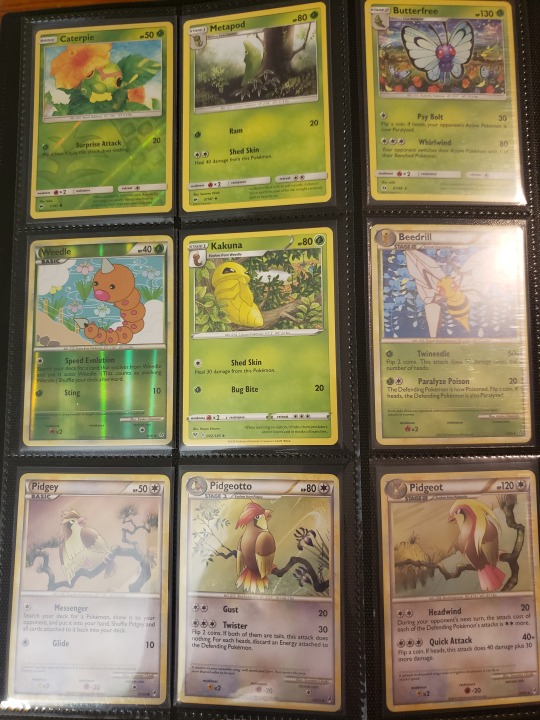
We are out of the starters page and into things proper. I know I have Pokemon brain-worms from having red/blue come out when I was a small child, but this page just has so many of my favorite guys.
For most of this set, I tried to have different artists represented for each Pokemon, and trying to repeat as little as I can across the entire collection, but I couldn't resist both Kyoko Umemoto's Weedle and Beedrill. I also went with the full Pidgey line by Suwama Chiaki, as the art was just too good.
#1 Card of the Page
Pidgeotto ~ Call of Legends 45/95 ~ Suwama Chiaki

These are all excellent birds, but Pidgeotto is my favorite of Chiaki's trio for Call of Legends. I love all of the small details in the plant life and water, as well as the highly dynamic pose.

I feel like there is a perceivable story to these cards (which I think became more common as time went on). The Pidgeotto seems to stare straight at the viewer. What was the Pidgeotto doing? What are you doing, for that matter, interrupting it's moment of contemplation like that?
Bonus Detail:
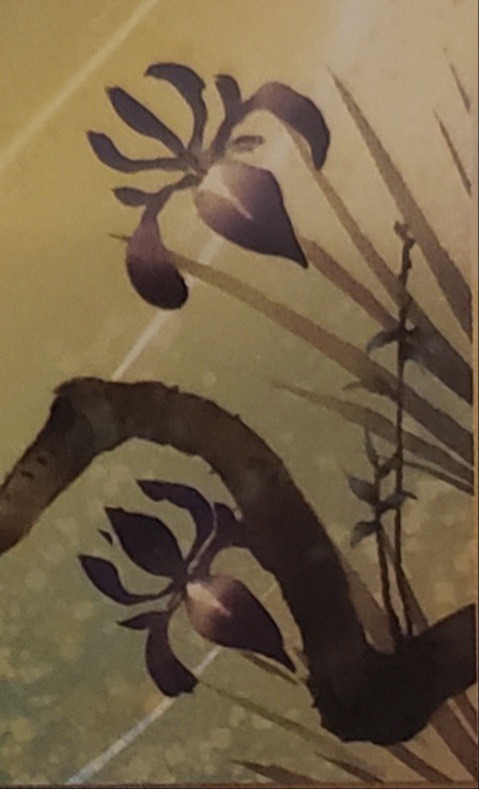
I always adore the plant life shown in Pokemon cards. I'm terrible at identifying real life plants, so I can never tell if something is based on a real flower, but I'm nearly certain that's reminiscent of an orchid? (if anyone knows, I'd love to know too!) I love looking at plants in general. Perhaps I should learn something about them as well. (Did you know? Many plants...green.)
This also gets me thinking. In the world of Pokemon, if everything living is Pokemon, does that mean this and every other plant are just a silent Pokemon? Or is there perhaps some delineation. At what point of awareness does something go from a plant to a Pokemon? There are already Pokemon based on plants, but they live around regular plants as well. This is more of a taxonomical thought experiment, I guess. What do you think?
#emareep#pokemon card collecting#pokemon tcg#emareep kanto dex collection#emareep cards#pidgeotto#call of legends#Suwama Chiaki#pokemon science#gen 1#flying type
3 notes
·
View notes
Note
Rai! I just had this random thought. What if you put salt on a Goodra?
Next to nothing would happen, maybe a rash at worst.
It would take quite a lot of salt to inflict any serious issues, but at that point the same thing happens to humans.
While Goodra is primarily composed of water, it's Dragon Typing keeps it from being almost completely liquid.
This type of thing would affect a Gastrodon or Jellicent much worse.
Now if you did this on a Goomy there would be much more discomfort.
Of course I do not recommend doing this as it would be considered cruelty.
But in the past there have been reports and experienments and this is the result.
So let's not do anything bad to them, no matter how curious we get.

#ranger rai#pokemon ranger#the ranger base#pokemon#ask me anything#ask me a question#sinnoh#goodra#goomy#gastrodon#pokemon science#be kind to pokemon
24 notes
·
View notes
Note
When a ditto turns into an inanimate object, what happens to its organs?
Another great question about an interesting Pokémon!
So the short answer - ditto doesn't have organs. I think Ditto is a sort of slime mold. It is like a conjunction of billions of individual cells and protoplasm that all communicate instantly with one another to relay information. Specialized cells near its head (again, no organs or body parts so we have to use the terminology with a grain of salt) have been adapted to perceive light, colour and shapes in the form of eyes, as well as cells that can vibrate, relax and contract, to provide sound and a mouth. Every other cell in its body shares information through the protoplasmic soup that is its body, and since this information is shared at a similar speed and way as neurons in humans at speeds of 50 meters per second or 100 miles an hour, it can transform almost instantly.

Here's another interesting question: are Ditto man made?
Well, for those of you who don't know the Ditto and Mew theory, it basically says that Dittos are failed cloning attempts at Mew. Mew is the only other Pokémon that can learn transform, which makes sense since it is the ancestor of all Pokémon. So in theory it should house all of the genetic makeup to potentially give rise to any Pokémon to ever exist. Ditto are found all over Cinnabar Mansion, which is where the cloning experiments were conducted on Mew. They both also have the same weight, size, and shiny colour.
So I personally believe that ditto can be found both in the wild and are man made. There are ditto on Route 34 and 35 in Gold, Silver, and Crystal, so I don't believe that all of the ditto in the world are purely man made. However I struggle to find the connection between man made and wild Ditto. Are they completely identical genetically? If they all have the same genetic makeup as Mew, then could wild Ditto just be globs of wild Mew that fell off somehow? Perhaps wild Ditto reproduce asexually as real life slime molds do, and for minute genetic diversity they intermingle and share cells with other Ditto that came from Mews somehow.
Lots to think about! Thanks for the question, I hope I answered it!
25 notes
·
View notes
Text
“Hoomon” is a hypothetical Pokemon ancestor of human beings. It is a Fighting/Normal type that resembles a furry caveman.
The scientist who designed it later deleted his social media after people began spamming his posts with “Ungabunga”, an alternate name for Hoomon that went viral.
#pokemon headcanons#pokemon science#idk i just thought this was funny#we probably evolved from timburr realistically
98 notes
·
View notes
Text
I read forever ago, about some group of pokemon breeders and reaserchers trying to bring back the ancient hisuian variant of growlithe by selective breeding. I dont remember where i found it tho or if they've been sucesfull but i still find it kinda interesting, should try to look up something more about them
3 notes
·
View notes
Text
How do pikachu hear? Their ears, if they can be called that, have no opening. They could be false ears like owls have that actually used for something else. But that would mean pikachu have ear holes and that disturbs me… so any theories?

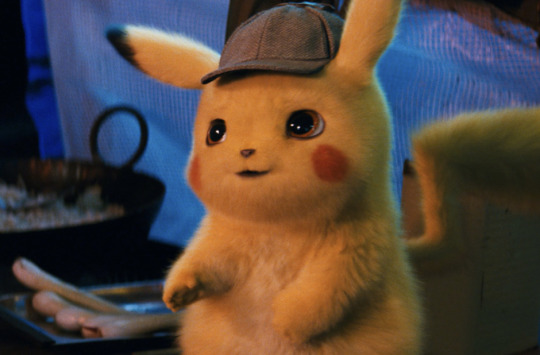
#pokemon#pokemon science#question#pls hlp#Im so confused and theories just disturb me#I would go to game theory but I don’t think they cover this any of their Pokémon theories#if they do have ear holes then what are the antenna(?) used for#owls fake ears are display feather#what are the pikachu not ears for#maybe something to do with electricity#BUT HOW DO THEY HEAR???
6 notes
·
View notes
Text
Tropious is quite a lovely pokemon. The fruits around its neck are evolved as a food storage. Because they tend to take on a similar colour and taste due to a pokemon's diet the myth that it is the fruit around its neck is always the same kind it eats.
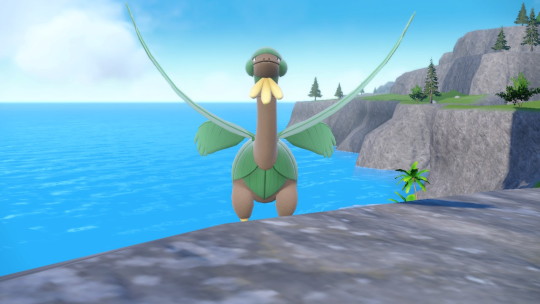
These pokemon can fly and due to their fruit stores they can travel massive distances between feeding grounds. So anywhere it's warm enough for them, and there's enough sweet fruit they will be found.
It's no different with the Paldea region, where they are mainly found wild, as the most farmed pokemon is smolive.
Where tropius is farmed, it has been bred to produce larger and richer fruits.
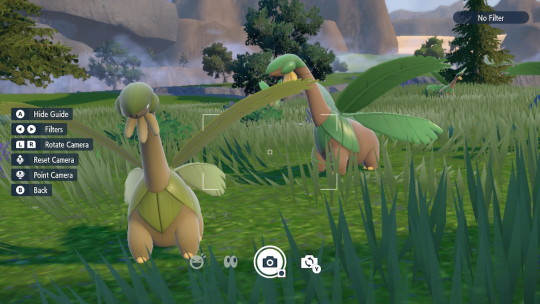
While interacting with this herd, I found a shiny. It is well accepted by the herd, so I left it as is. Though I did make a note to keep an eye on it in case poachers go for it.
They are quite friendly, and due to their large size I recommend caution when interacting with wild ones, as they may accidentally cause harm when trying to snuggle a human.
#pokemon#pokemon professor#professor mystic#tropius#pokemon scarlet and violet#pokemon science#pokemon headcanons#unreality#this is not canon#just headcaon
4 notes
·
View notes
Text
Bulbasaur (Phytobestia bulbus) Species Overview
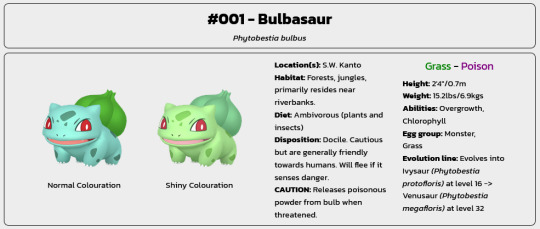
Summary
Bulbasaur are very popular partner Pokémon in the Kanto region due to their docile nature and their relaxed care routine. Because of their general well behaviour, they are bred to be given to new trainers as starter Pokémon. While they are common partner Pokémon, they are quite rare in the wild. The bulbs on their back contain nutrient-rich seeds that are planted there at birth and provide them energy through photosynthesis. However, they still require a regular diet of both insects and plants to remain healthy. Their scientific name, Phytobestia bulbus, roughly translates to "bulbed plant-beast."
Biology
Bulbasaur are quadrupedal amphibian Pokémon. Their skin is blue-green, dotted with darker patches. Their pointed "ears" are mainly used to convey emotions to other Pokémon and humans, as their real ears are located behind these structures. They have big, red eyes with white pupils, a wide mouth and a blunt snout. Located on their back is a bright green bulb that provides them with energy using photosynthesis and the nutrients within the seeds inside the bulb. This bulb conceals two, tentacle-like vines, which are mainly used for combat, but have other uses as well. Their colouration and natural appearance allows them to camouflage incredibly well.
Despite being amphibious, Bulbasaur do not spend nearly as much time in or around water as much as other amphibious Pokémon. Though their eggs are laid in water, this is mostly to regulate the egg's temperature and keep it from overheating, as the egg needs to be within a certain range of degrees in order for the seeds on Bulbasaur's back to grow properly before hatching. After hatching, newborn Bulbasaur will still spend time in and around water until their bulbs grow large enough to provide them with enough energy. Once ready, young Bulbasaur will leave their hatching ponds and begin living independently.
Their skin glands produce useful proteins that are used to fight bacteria and fungal infections. Their skin has an incredibly bitter taste and, depending on the Bulbasaur's age, could be somewhat poisonous, so predators are generally discouraged from hunting them.
Behaviour
Diet/Eating Habits
Bulbasaur are ambivores, meaning they feed on several different kinds of food. They are primarily insectivorous, but do consume specific plant species when needed. They are natural predators of Caterpie, Metapod, Butterfree, Weedle, Kakuna and Paras, but on rare occasions have been observed to pursue larger, more dangerous insects such as Beedrill and Parasect.
When hunting, Bulbasaur take advantage of their camouflage and hide in bushes, waiting to ambush prey. They often wait near areas where their prey congregate to eat, before grabbing their prey with the vine-like tentacles in their bulbs and sedating them with spores released from their bulbs. The effectiveness of these spores depends on the age of the Bulbasaur.
Bulbasaur also enjoy several fruits. They are not picky eaters and can eat many berries that other Pokémon cannot thanks to their poison typing.
A large percentage of their energy comes from photosynthesis, which feeds the seeds within the Pokémon's bulb important nutrients, which is then converted into energy. Bulbasaur can be observed basking in the sun quite often, although they will not bask for too long, as they run the risk of their skin drying up in the sunlight.
Communication and Relations with Humans and Pokémon
Bulbasaur typically communicate using a series of high-pitched squeaks and barks. These noises are used most commonly when communicating with other Bulbasaur or other members of the Phytobestia genus. They also emit low, growling croaks when agitated or startled (brr-ah-ow-grrr!).
Bulbasaur are very loyal to their trainers, even after long-term abandonment. They are well-behaved and will follow trainer commands without complaint. They are very docile and friendly towards humans, to the point where some domestic Bulbasaur have been observed to try to interact with trainers passing by. They are very sensitive to their trainer's emotions, and will often try to cheer them up by cuddling with them or bringing them gifts (usually plants or flowers).
Bulbasaur are also particularly friendly towards other Pokémon, although wild Bulbasaur are more cautious. Bulbasaur have demonstrated a nurturing, caring instinct when interacting with younger Pokémon. They are more inclined to help their trainers care for the other Pokémon in their party and even help injured Pokémon in the wild.
Every year, many Bulbasaur will gather in a hidden Kantonian garden to undergo evolution together. These ceremonies are overseen by a Venusaur (Phytobestia megafloris). The location of these ceremonies is classified information and is protected land under Kantonian law, meaning humans are not allowed to observe or participate unless they are biologists and are observing from a safe distance.
#pokemon#pokemon biology#pokemon science#pokemon zoology#pokemon professor#bulbasaur#ask blog#g: phytobestia#r: kanto#species overview
21 notes
·
View notes